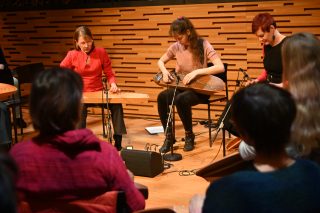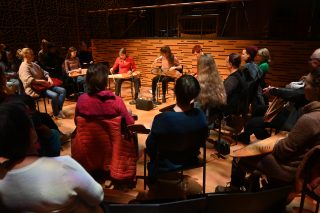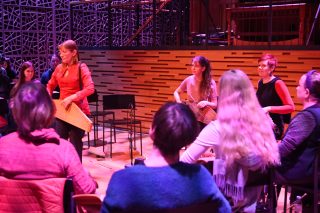A concert where the audience created the music
Blog
February 27, 2023
The Kanteletupa-concert at the Organo hall of the Helsinki Musiikkitalo on the 11th of February, 2023, was an experiment born as part of research at the University of the Arts Helsinki, perhaps with slightly uncertain expectations at the beginning and at the same time firmly relying on a musical-philosophical theory about improvisation and creativity.
In the concert, it was decided to allow the audience to participate in the construction of music. Perhaps contrary to the pre-expectations of many (including me), the experiment was successful beyond expectations, hip-hip-hooray! An unforgettable experience – a concert where the audience created the music.
The whole concept is based on the idea, which is an obvious part of folk music pedagogy, that making music is not only the privilege of the few but a part of humanity that has belonged to everyone since time immemorial. Therefore, creativity and the possibilities of individual realization of creativity also measure the equality, crisis resistance, and prospects of community and society.
The degree program in folk music will celebrate its 40th anniversary at the Sibelius Academy in the coming school year, and this concert was already an early part of the events of the jubilee year. A good thing should be celebrated for a long time and thoroughly.
We organized the Kanteletupa-concert with a workgroup of three: Pauliina Syrjälä, Eva Väljaots, and me, Arja Kastinen.

Photo: Jorma Airola 11.2.2023. From the right: Pauliina Syrjälä, Eva Väljaots and Arja Kastinen.
Two large carts full of small kanteles had been brought into the hall from the Folk Music Department for the audience to use. Pauliina and Eva offered them to everyone who wanted to play and came without an instrument. People kept on coming and coming, and in the end, we run out of kanteles!
We weren’t prepared for this: people were annoyed because they can’t play along, even if they wanted to!
The event started with a 10-minute introduction for those who had not participated in the three workshops preceding the concert. The instructions aimed to ensure smooth participation even for those who were not familiar with the instrument: what we are doing, how and why, and what is the goal. There were surprisingly many non-Finnish speakers present, so in the background, Eva translated the instructions into English.
Small kanteles – and especially the five-string kantele – are ideal instruments for this kind of interaction, because the instrument is both easy and multidimensional at the same time. It enables equal musical communication between musicians and non-musicians. From the musicians, this requires an attitude and a willingness to put themselves on the same page as the beginners.
One student musician stated after the concert that she got a strong experience of the communal meaning of music – you don’t have to play something super complicated, but you can really focus on listening to the quality of the sound and contributing to the soundscape. She stated that the experience of combining beauty and simplicity really struck her aback.
In this way, the jointly created sound field obscured the importance of individual performances other than as a part of the whole. Possible technical problems as well as virtuoso performances merged into the same entity as equals.
It is difficult to convey the essence of such a musical event and creative process through teaching and explaining – experience is needed to understand tacit information and that was one of the strong reasons for organizing the event.

Photo: Jorma Airola. The intro.
The music of the concert began with a short intro played by Pauliina, Eva, and me. In it, various examples of playing techniques and possibilities were interspersed in the quieting atmosphere.

Photo: Jorma Airola. After the intro, the audience comes along.
After the intro, Pauliina and Eva continued to play lightly amplified – they made sure that the music’s structures and occasional pulse were in our control. I started to wander among the audience, giving signs, instructions, and tips with gestures.
The music that started with one tone gradually expanded to cover all the strings of the kantele – thus a slowly growing sound field was born. In the video below, there is a clip of about half a minute from the phase when the sound field is established and everyone has the freedom to use all strings.

Photo: Jorma Airola 11.2.2023. Solos from the audience.
After the soundscape had been established, dynamic variations were added and individual solos were brought out from the audience.
Now this required courage and it was indeed found: incredibly wonderful dedication from everyone. Acceptance of uncertainty, openness to face what comes next, trust in the community’s capacity to carry everyone – all the elements of the philosophy underlying the concert seemed to be in common understanding as if built-in.
Below there is a short video clip of a few solos.
After the initial even rhythm, the pulse was changed to a 5/8 rhythm, and with the 10–11-string kantele, a change of hand position was done between the 1st and 2nd scale degrees.
The small kantele improvisation of the older tradition, on the aesthetics of which the concept of the concert is based, was part of the Finnish-Karelian runosong culture. There are many different rhythm types in the runosongs, and that’s why we decided to consciously try a few at the concert: if the people in ancient times have used these in their everyday life, why not us as well? Enough repetitions and the extraordinary becomes ordinary.
This is also related to the philosophical-pedagogical idea that people’s abilities and possibilities should not be underestimated. People from different backgrounds can equally perform a wide variety of tasks if they are given the opportunity and support.
In addition, the goal was to subtly open understanding to acceptance: it doesn’t hurt if you are not exactly at the same phase as your fellow musicians in terms of structural changes or rhythms. The changes in the music were allowed to be slow and intertwining. In this way, interesting structures were created and the music became a multidimensional, organic weave that took shape along with its creators.
It was a plan that after the intense 5/8 rhythm, there would be a pulseless phase, where various sounds, knocks, harmonics, muted sounds, etc., would be added – whatever sounds anyone could come up with + melodic phrases. At this point, things started to get really interesting: the attentiveness increased, the fear and tension of playing had disappeared, people started to make their own musical decisions with more courage, and the structure of the music began to live a life of its own.
As mentioned in studies of intuition (see e.g. Asta Raami 2015, Intuition unleashed), forgetting oneself can help to open a path to the subconscious and intuition that comes from outside of conscious knowledge. Merging in the soundscape and trusting its support helps to let go of tension, fears, and other limitations that prevent creativity, and the player can focus on listening, observing, and reacting.
Moving towards the end, the more complex 10/8, i.e., 3 + 3 + 2 + 2 rhythm, planned in advance and practiced with the workshop participants, was taken as a basis. The rhythm with its melody line was repeated again and again, and gradually it became established as a soundscape, on top of which you could freely create different sounds and melodic phrases.
Do I hear right or is there someone singing along?

Photo: Jorma Airola. Listening to the final phase.
From my point of view, perhaps the finest moment was the closing part, where I could just sit and listen as the music progressed on its own, and found its route to the ending. Controlling or guidance was no longer needed: music had become an organic part of our small, randomly composed community.
Good conditions contributed to the success of the event. The atmosphere and the beauty of the Organo hall, together with the lighting engineered by Sirje Ruohtula, was clearly a meaningful experience for many participants. Also in this sense, the event was what we wanted: the grand Musiikkitalo is not meant just for the few but is, and should be, an open and low-threshold opportunity for everyone.
Several feedbacks mentioned a meditative and relaxed state of being where it was easy and natural to focus on the music. The music was felt to appear without pressure or trying hard. At the same time, from a beginner’s point of view, it also felt important to progress slowly and to start with simple enough things.
Sensing other people and the experience of community through music also came out clearly in the feedback. Likewise, the disappearance of the fear of playing wrong. One participant beautifully described how sometimes, when she felt like she didn’t really know what to play, by listening to others, she seemed to find herself and her own voice again and knew what to do.
The diagram of creative dialogue built in the research project behind the concert, based on the philosophy of democratic dialogue, was realized almost perfectly in the concert:

In the future, we will write a research article with the concert working group analyzing the event more deeply.
The research also continues: the next workshop will be organized on June 12-14, 2023 at the Kallio-Kuninkala in Järvenpää. Welcome aboard!
